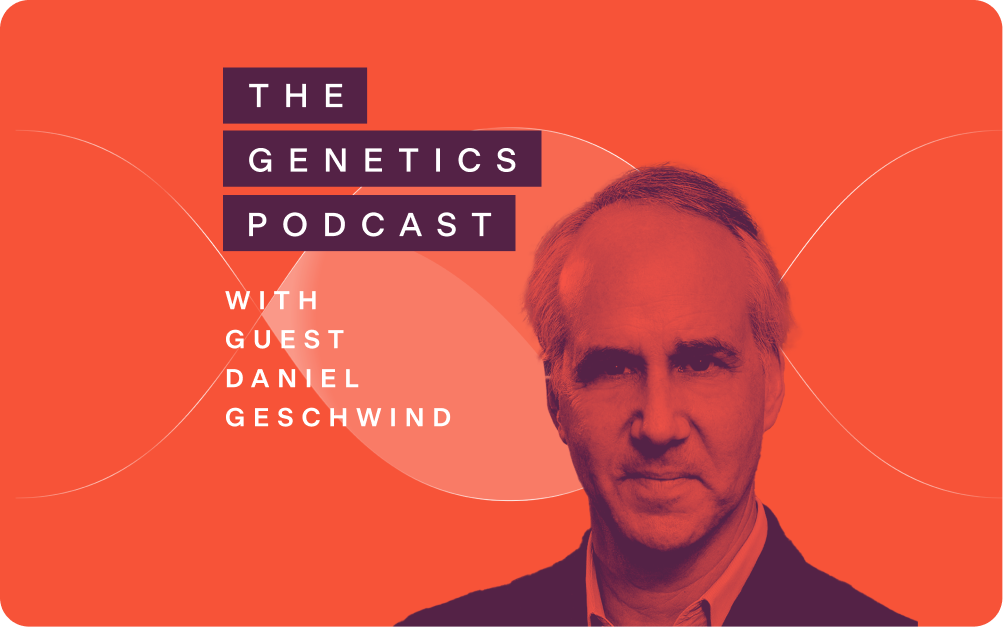Podcast recap: Dr. Daniel Geschwind on autism genetics

On a recent episode of The Genetics Podcast, Patrick spoke with Daniel Geschwind, Senior Associate Dean and Associate Vice Chancellor of Precision Health at UCLA and Professor of Human Genetics, Neurology, and Psychiatry. They discussed how autism genetics has evolved over two decades, what makes neurodevelopment so complex, and how emerging technologies like RNA therapeutics could transform care for rare genetic forms of autism.
A non-linear path to science
Before becoming a world-renowned researcher, Daniel spent two years at Boston Consulting Group. He enjoyed the experience but found himself craving a more impactful career. With a background in chemistry and a family full of scientists, he decided to apply to MD/PhD programs with an interest in brain development and disease.
A year off from college filming ski movies in France gave Daniel clarity about his future. His passion for understanding the brain eventually led him to study autism, thanks to a relationship with a family who founded Cure Autism Now. At the time, little was known about autism at a molecular level, but twin studies had revealed strong heritability. Daniel decided to co-create the biobank AGRE, the Autism Genetic Resource Exchange, to jumpstart the field. His efforts helped lay the groundwork for autism genetics as we know it today.
Rethinking autism: not one disorder, but many
Daniel emphasized that autism is not a single disease but a spectrum, and possibly better viewed as a set of overlapping syndromes. “It’s like height or weight,” he explained. “There’s a continuum of social cognition, language, and flexibility.” His early research approached autism as a quantitative trait, exploring how polygenic risk factors influence features like language ability, which was long thought to be central to autism even if it’s now de-emphasized in diagnostic criteria.
In parallel, his lab pioneered the use of transcriptomics to define molecular pathologies in psychiatric conditions. In a landmark study, his team identified a consistent gene expression signature in autism brain tissue, a finding that could help stratify cases in the future and guide more targeted therapies.
The rare gene–common disorder paradox
Roughly 15% of autism cases involve rare, high-impact mutations that are usually de novo. While each of these variants may account for only a small number of individuals, they offer powerful insights into disrupted pathways and cell types during early fetal development.
However, studying one gene at a time isn’t enough. The pleiotropic nature of autism spectrum disorders complicates modeling and treatment. For example, SCN2A mutations can cause epilepsy, intellectual disability, and autism, depending on context. Identifying common mechanisms remains a central challenge but holds promise for a better understanding of the disorder as a whole.
A hopeful future: gene regulation and RNA therapeutics
Because many autism-linked mutations are haploinsufficient, meaning they knock out one working copy of a gene, new tools like CRISPR activation or RNA stabilization may allow researchers to selectively restore expression from the remaining healthy allele.
Targeting enhancers rather than promoters could also yield better precision, activating genes in the right tissues at the right times. Delivery remains a technical hurdle, but the field is progressing rapidly. Daniel expressed hope in this regard and predicted that the technology could advance rapidly enough that autism could be treated in utero by the time he’s retired. However, he noted that gene therapy alone won’t be a silver bullet, he noted. For postnatal intervention, it will likely need to be paired with behavioral training to support meaningful improvements.
Data sharing and diversity: two keys to progress
Daniel has long championed open science, helping lead initiatives like AGRE, Simons, PsychENCODE, and the Autism Genetics and Human Diversity Project. The latter focuses on expanding autism genetic research in African American populations who have historically been excluded despite having the highest burden of rare inherited variation.
He also emphasized the untapped potential in integrating genetic data with electronic health records (EHRs). At UCLA, their biobank now includes over 130,000 genotyped individuals, and has already replicated numerous known genetic associations. This demonstrates how large-scale, real-world data can enable precise, scalable phenotyping, and why increasing diversity in these datasets is essential for making biomedical research truly inclusive and broadly applicable.
Listen to the full episode here:
